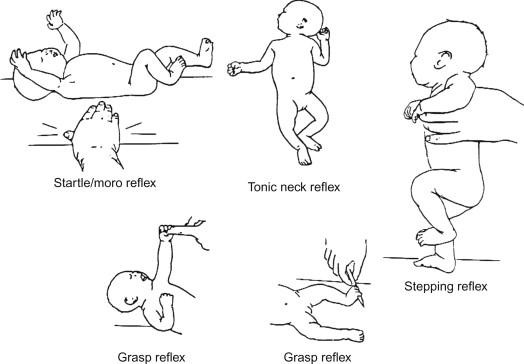The nurse is doing a neurologic assessment on a 2-month-old infant after a car accident. Moro, tonic neck, and withdrawal reflexes are present. The nurse should recognize that these reflexes are:
Symptomatic of decorticate posturing
Symptomatic of decerebrate posturing
Indicators of severe brain damage
Normal Findings
The Correct Answer is D
Reflexes play a crucial role in evaluating the neurological status of infants.
Moro reflex: Also known as the startle reflex, the Moro reflex is a normal response in infants. It occurs when an infant is startled by a sudden noise or movement. The baby responds by extending their arms and legs, followed by a quick contraction. This reflex usually disappears around 4-6 months of age.
Tonic neck reflex (fencer's reflex): This reflex involves turning an infant's head to one side, causing the arm on that side to extend and the opposite arm to flex. It's a normal reflex that typically disappears around 4-6 months of age.
Withdrawal reflex: The withdrawal reflex is a normal response to a stimulus, such as touching a baby's foot with a cold object. The baby will pull their leg away in response to the stimulus.
Symptomatic of decorticate or decerebrate posturing (options A and B):
Decorticate and decerebrate posturing are abnormal postures seen in individuals with severe brain damage or injury. Decorticate posturing involves the arms being flexed and held close to the body, while decerebrate posturing involves the arms being extended and the wrists being pronated. These reflexes are typically indicative of significant neurological dysfunction and are not expected in a 2-month-old infant after a car accident.
Indicators of severe brain damage (option C):
The reflexes described (Moro, tonic neck, and withdrawal reflexes) are not indicative of severe brain damage in a 2-month-old infant. These reflexes are normal for an infant of this age and are part of their typical neurological development.
Normal findings (option D):
The reflexes described are normal findings in a 2-month-old infant and are expected as part of their developmental milestones.

Nursing Test Bank
Naxlex Comprehensive Predictor Exams
Related Questions
Correct Answer is D
Explanation
A) "I can store unopened bottles of insulin in the freezer."
This statement is incorrect. Insulin should not be stored in the freezer. Insulin should be stored in the refrigerator, and the currently used vial can be kept at room temperature for up to 28 days to avoid the discomfort of injecting cold insulin.
B) "I should not take my regular insulin when I am sick."
This statement is incorrect. When a person with type 1 diabetes is sick, it's important to continue taking insulin. In fact, during illness, blood sugar levels can become more difficult to manage, and insulin may be needed in adjusted doses. Skipping insulin during sickness can lead to uncontrolled blood sugar levels and potentially worsen the illness.
C) "My morning blood glucose should be between 90 and 130."
This statement is a good range to aim for in terms of fasting blood glucose levels, but it's not an indication of understanding the teaching about diabetes management as a whole. While this knowledge is important, the statement about eating a snack before playing soccer directly reflects understanding of how to manage blood sugar during physical activity.
"D) I should eat a snack half an hour before playing soccer."
Explanation:
Managing blood sugar levels is crucial for individuals with type 1 diabetes, especially when engaging in physical activities like playing soccer. Eating a snack before playing helps prevent hypoglycemia (low blood sugar) during exercise. Physical activity can cause the body to use up glucose faster, potentially leading to low blood sugar levels, and having a snack before exercise can help maintain stable blood sugar levels.
Correct Answer is A
Explanation
A. Inattention, Hyperactivity, Impulsivity
Explanation: Attention Deficit Hyperactivity Disorder (ADHD) is a neurodevelopmental disorder characterized by symptoms of inattention, hyperactivity, and impulsivity. These symptoms can significantly impact an individual's ability to function in various areas of their life, such as school, work, and social interactions.
The other options are not accurate descriptions of ADHD:
B. "Can never be well treated" is not correct. ADHD can be effectively managed and treated through a combination of strategies, which may include behavioral interventions, psychoeducation, counseling, and in some cases, medication.
C. "Inability to learn" is not a defining characteristic of ADHD. While individuals with ADHD might face challenges in learning due to their symptoms, they are certainly capable of learning and can benefit from tailored strategies to support their learning process.
D. "Excess tiredness, impulsivity, and hyperactivity" describes a combination of symptoms, but ADHD is specifically characterized by inattention, hyperactivity, and impulsivity. Tiredness, while not a primary symptom of ADHD, can be a secondary effect of difficulties in focusing and maintaining attention.
Whether you are a student looking to ace your exams or a practicing nurse seeking to enhance your expertise , our nursing education contents will empower you with the confidence and competence to make a difference in the lives of patients and become a respected leader in the healthcare field.
Visit Naxlex, invest in your future and unlock endless possibilities with our unparalleled nursing education contents today
Report Wrong Answer on the Current Question
Do you disagree with the answer? If yes, what is your expected answer? Explain.
Kindly be descriptive with the issue you are facing.
